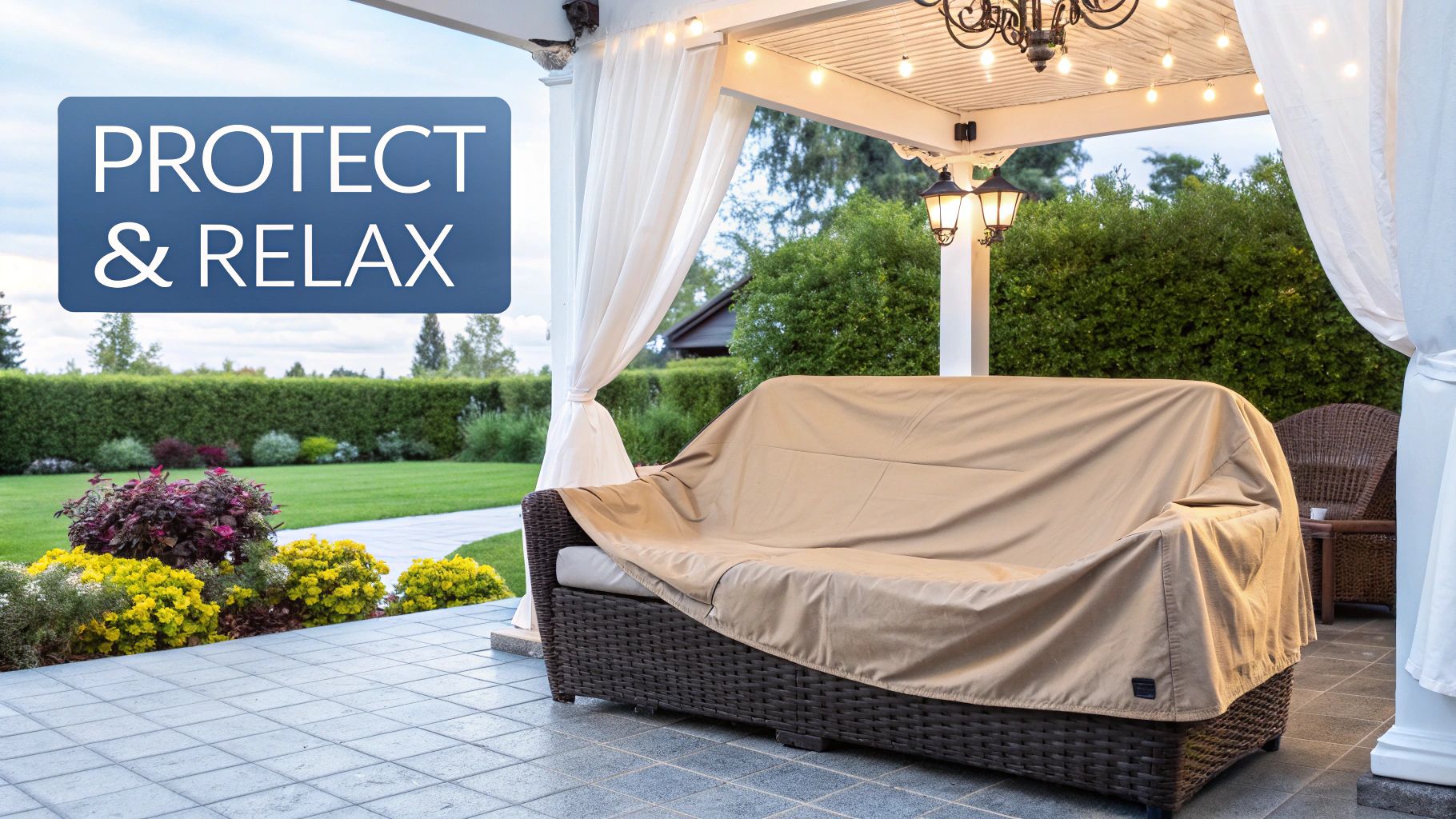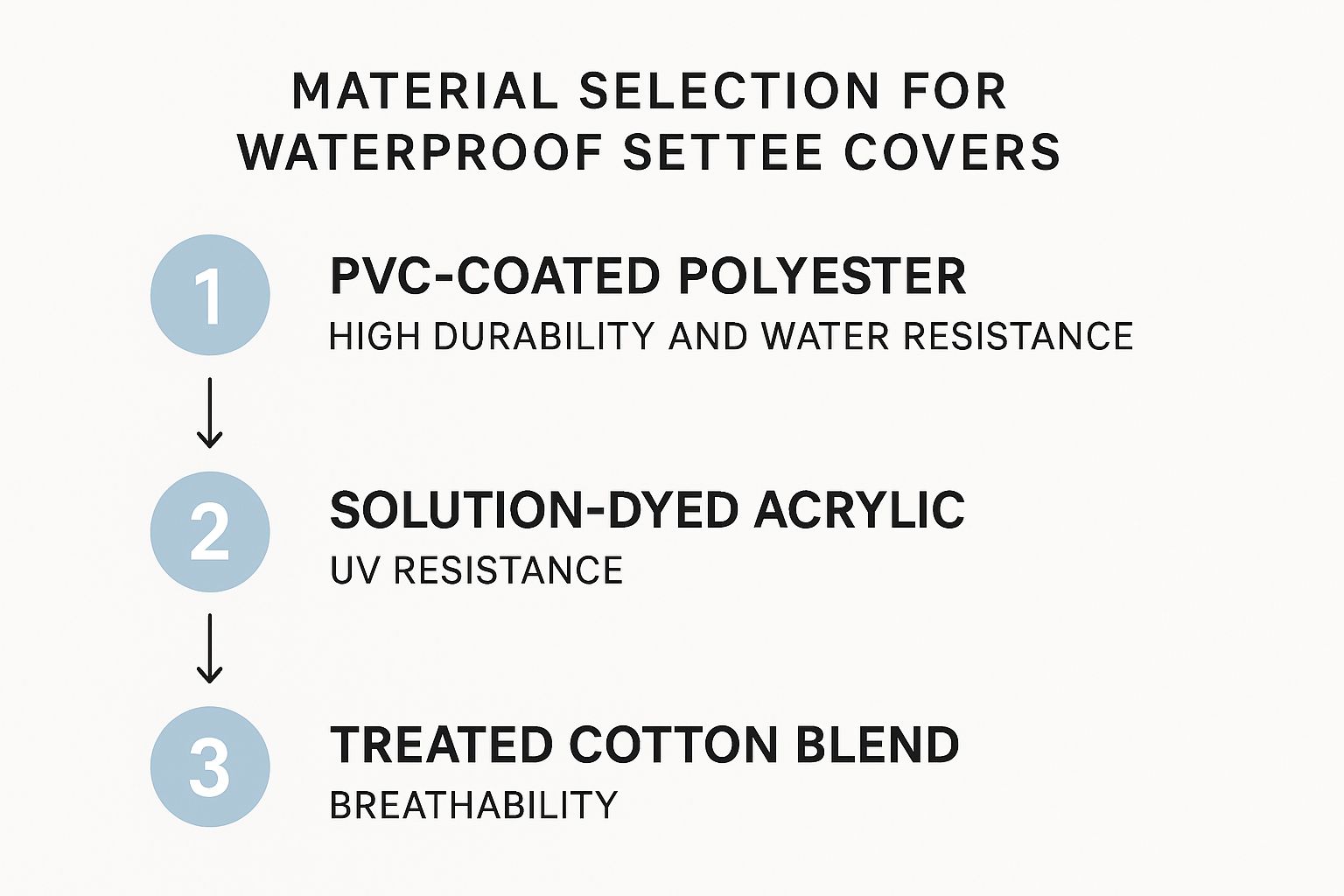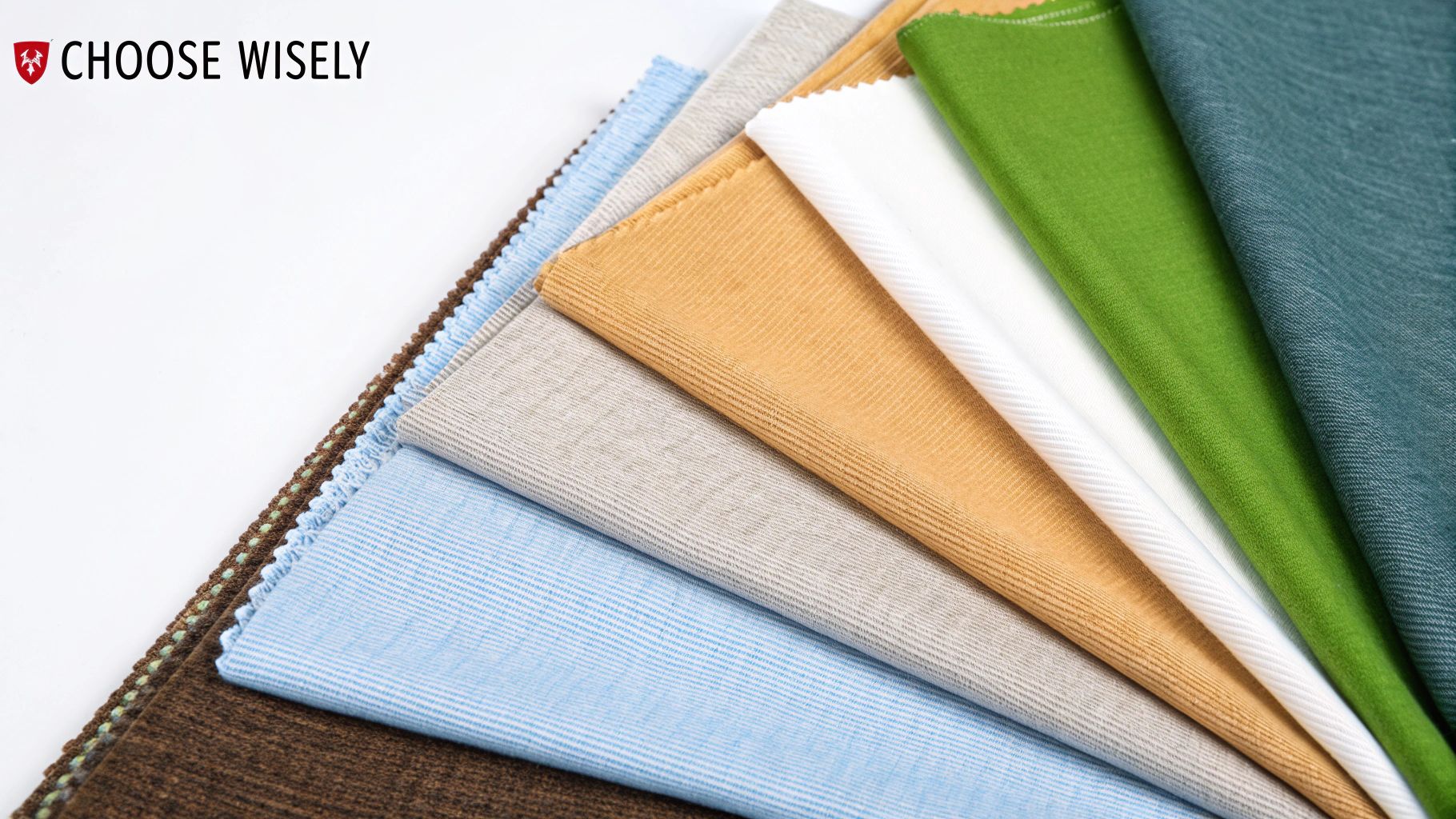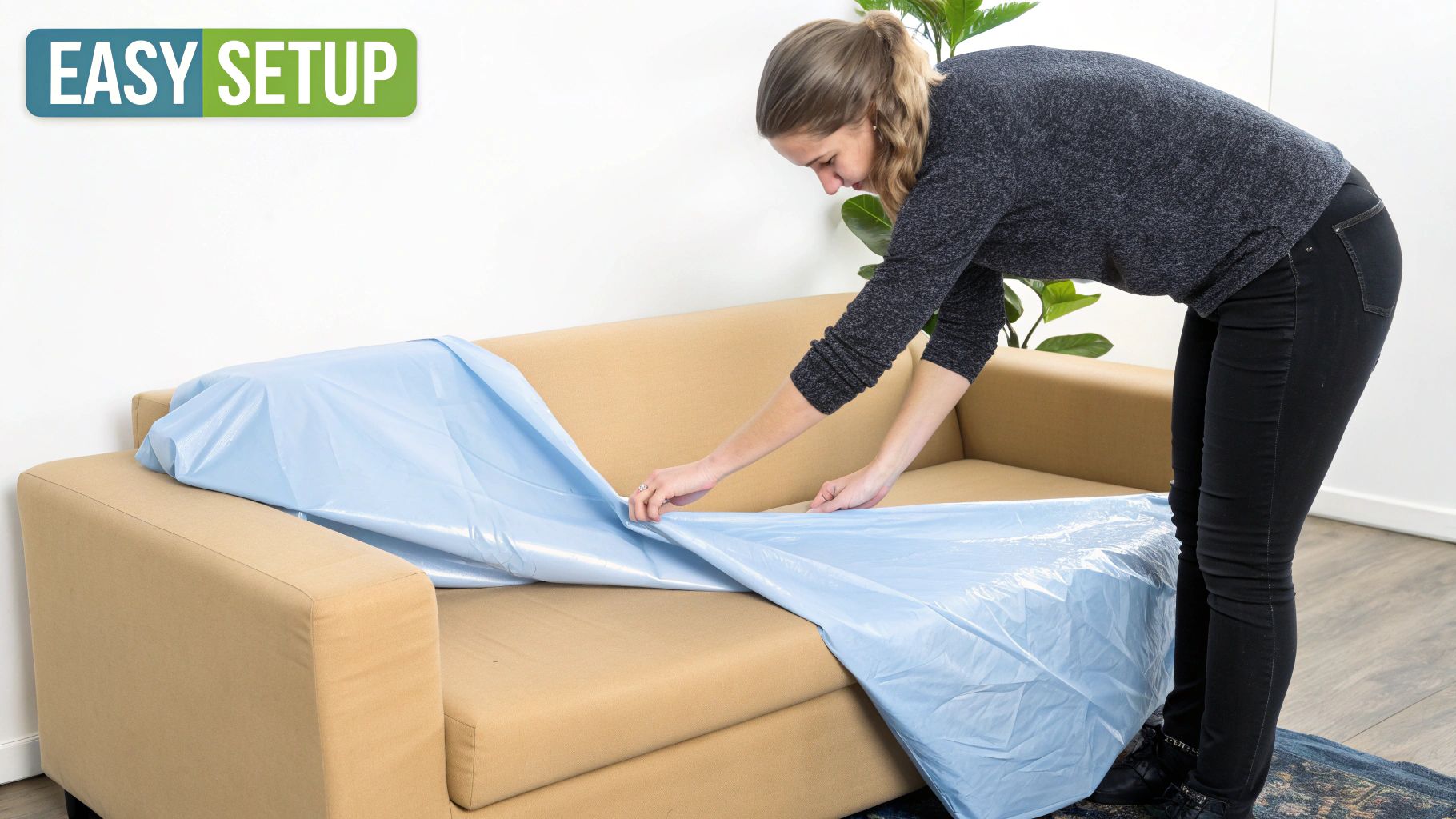A waterproof settee cover isn't just a simple sheet of fabric you throw over your furniture. Think of it as a custom-made shield, engineered to be a complete barrier against liquids. It’s the first and last line of defence for your settee, keeping it dry, clean, and looking new for years to come.
Why Australian Homes Need Waterproof Settee Covers
Picture this: you're hosting the perfect backyard barbie, the snags are sizzling, and then a classic southerly buster appears out of nowhere. Everyone dashes inside, but your outdoor settee is left to face the downpour. Sound familiar? For most Aussies, it's a common story.
That's why a high-quality waterproof settee cover is more than just a nice-to-have accessory; it's essential. It’s about protecting one of your biggest household investments from our uniquely unpredictable weather and busy, often messy, lifestyles.
Defending Against the Elements
The Aussie climate can be brutal on furniture, both inside and out. The harsh sun beats down, its UV rays bleaching vibrant fabrics until they're a pale, washed-out memory of their former glory. It also makes materials like timber and wicker brittle, leading to cracks and splintering.
And then there's the moisture. From the thick humidity of a coastal summer to a sudden downpour, dampness creates the perfect breeding ground for mould and mildew, leaving behind stubborn stains and a musty smell you can't get rid of.
A good waterproof settee cover stands guard against it all. It offers:
- Complete rain protection, stopping water from soaking into your cushions and frame.
- UV resistance to prevent sun-fading and material damage.
- A barrier against dust and debris, so your furniture is always clean and ready to go.
It's really just smart insurance for your settee. You're taking a small, proactive step to protect its condition and appearance, which saves you a fortune in costly repairs or having to replace it far too soon. For a deeper dive, check out our guide on choosing the right outdoor furniture cover.
More Than Just Weather Protection
These covers are lifesavers indoors, too. If you've got kids or pets, you know the daily struggle. A waterproof cover offers genuine peace of mind against the inevitable spills, muddy paws, and everyday accidents.
Instead of panicking when a glass of red wine goes flying, you can just pull the cover off and pop it in the wash. Easy.
This everyday need has pushed local manufacturers to get creative. Many now use advanced film technologies to make covers that are totally waterproof but still feel lightweight and flexible. It’s the perfect solution for furniture that has to stand up to both torrential rain and scorching sun. This focus on durability means today’s waterproof settee covers are a practical, and often stylish, necessity for any Aussie home.
Selecting the Right Fabric for Ultimate Protection

Choosing the right waterproof settee cover goes far deeper than just picking a colour that matches your garden furniture. The real hero of the story is the fabric it’s made from. Not all materials are up to the task, especially when you’re dealing with the unpredictable and often harsh Australian climate.
First things first, let's clear up a common point of confusion: 'water-resistant' versus 'waterproof'. Think of a water-resistant cover like a light windbreaker. It'll fend off a bit of morning dew or a quick, light sprinkle, but it will eventually soak through in a proper downpour.
A genuinely waterproof cover, on the other hand, is your heavy-duty raincoat. It's been specifically engineered with coatings and materials that create an impenetrable barrier against moisture. This means even during a torrential storm, your settee stays bone dry underneath.
Key Materials Used in Settee Covers
When you start looking at product descriptions, you'll see a few fabric names pop up again and again. Each one offers a different blend of durability, protection, and breathability. Knowing their pros and cons is key to choosing the perfect shield for your settee.
-
PU-Coated Polyester: This is a crowd favourite for a good reason. Polyester is a tough synthetic fabric on its own, but the real magic comes from the Polyurethane (PU) coating. This layer makes the fabric highly water-resistant or even fully waterproof, depending on its thickness. A tip from the pros: look for a high "denier" number, like 600D, which signals a thicker, more durable weave.
-
Vinyl (PVC): Vinyl is waterproof right out of the gate, making it a go-to for heavy-duty covers. It offers fantastic protection from the rain and is an absolute breeze to wipe clean. The major downside, however, can be its complete lack of breathability—a critical factor we need to talk about.
While vinyl does the job, many people look for alternatives to traditional plastic sofa covers to get better airflow and avoid the problems of trapped moisture.
Waterproof Fabric Comparison for Settee Covers
With the Aussie climate in mind, from the humid coasts to the dry interior, choosing the right material is crucial. This table breaks down the common options to help you see, at a glance, what might work best for your backyard.
| Fabric Type | Waterproof Level | UV Resistance | Breathability | Best For |
|---|---|---|---|---|
| PU-Coated Polyester | High to Excellent | Good to Excellent | Moderate | All-round protection in most Australian climates; balances water protection with airflow. |
| Vinyl (PVC) | Excellent | Good | Very Low | Areas with heavy rainfall but low humidity; requires good ventilation to prevent mildew. |
| Solution-Dyed Polyester | Excellent | Excellent | Good | Sunny, high-UV environments where colour fading is a major concern. |
| PE Tarpaulin | Excellent | Fair to Good | Low | Budget-friendly, heavy-duty waterproofing for short-term or industrial use. |
Ultimately, the best choice often comes down to finding that sweet spot between blocking rain and letting the furniture breathe, especially in places prone to humidity.
Why Breathability Is a Deal-Breaker
It might sound strange to want a waterproof cover that can "breathe," but believe me, this feature is absolutely non-negotiable in Australia. A totally sealed fabric, like a simple plastic sheet, is a recipe for disaster because it traps condensation.
That trapped moisture creates a tiny, humid greenhouse right against your settee. This is the perfect breeding ground for mould and mildew. Before you know it, you're dealing with musty smells, stained cushions, and even rusted metal or rotted wood frames.
A quality waterproof cover has to do two things at once: stop rain from getting in, while letting moisture vapour from condensation get out. This dual-action design is what prevents the cover from accidentally damaging the very furniture it’s supposed to protect.
So, how do you get the best of both worlds? Look for covers with built-in air vents. These small, cleverly designed openings allow air to circulate, which lets any trapped condensation evaporate and keeps your settee fresh and dry.
Sun Protection and Long-Term Durability
The final piece of the fabric puzzle is its defence against the sun. The intense Aussie sun is brutal on fabrics, causing them to fade, become brittle, and crack over time. This is where UV inhibitors come in.
These are special compounds added to the fabric or its coating that act like sunscreen, absorbing or reflecting harmful ultraviolet rays. A cover with solid UV protection won't just hold its colour longer; it will also maintain its strength and resist tearing for many seasons to come. It’s the difference between a cover that lasts one year and one that lasts five.
How to Measure Your Settee for a Perfect Fit
There's nothing more deflating than finding the perfect waterproof settee cover, only to discover it doesn't fit when you get it home. It’s a classic Goldilocks problem – too tight and it'll rip at the seams under pressure; too loose and it’ll flap about, offering patchy protection and becoming a prime target for the next big gust of wind.
Think of it like buying a tailored suit. You wouldn't just grab one off the rack and hope for the best. The same logic applies here. Taking a few minutes to measure your settee properly is the key to getting that snug, secure fit that not only looks sharp but also provides the best possible protection.
Getting the Core Measurements Right
First things first, you'll need a flexible tape measure. The soft kind a tailor or sewer uses is perfect for this job. To get accurate numbers, always measure from the widest or outermost points of your settee.
For most standard settees, you'll only need to capture three key dimensions:
- Total Length: Start at the outside edge of one armrest and measure straight across the front to the outside edge of the opposite armrest. This is your most important number.
- Total Depth: Run your tape measure from the very front edge of the settee all the way to the back. Make sure the tape is taut, not dipping in the middle.
- Total Height: Measure from the floor right up to the highest point of the settee's back frame. A common mistake is measuring to the top of the cushions, but since they compress, you should always measure to the solid frame.
Jot these three measurements down. Having them handy will make it simple to check if a ready-made cover is the right size for your settee.
Measuring for L-Shaped and Modular Settees
L-shaped and modular settees are a staple in many Australian homes, but their unique shape means you need to be a bit more methodical. The trick is to treat each section as its own separate piece of furniture.
If you have an L-shaped settee, you’re basically measuring two intersecting sofas.
- First, measure the length of the main sofa section, from its outer armrest to the corner where it joins the other piece.
- Next, measure the length of the chaise or corner section, from its outer edge back to that same corner point.
- Finally, measure the depth and height for both sections individually, just as you would for a standard settee.
This two-part approach ensures you can find a cover (or set of covers) designed to fit each component snugly, leaving no gaps for rain or dust to sneak in. For a more detailed walkthrough, our comprehensive size guide provides step-by-step instructions for all sorts of furniture shapes.
Ready-Made Versus Custom Covers
With your measurements in hand, you’re at a crossroads: ready-made or custom? Ready-made covers are a fantastic, cost-effective option designed to fit common furniture sizes. They often come with handy adjustable features to help you get a tighter, neater fit.
On the other hand, custom covers are made-to-measure, crafted to your settee’s exact dimensions. They cost more, but they’re an excellent solution for oddly shaped furniture or if you're after that flawless, tailored look.
The image below breaks down some of the key things to consider when picking a fabric, which is just as important for both ready-made and custom options.

As you can see, it's often a balance between pure durability, UV resistance, and how well the fabric breathes.
Don’t Overlook Securing Features
Here in Australia, especially if you live near the coast or in a windy spot, a southerly buster can turn an unsecured furniture cover into a kite. A loose cover is a lost cover.
That's why good securing features are absolutely essential. When you're shopping around, keep an eye out for covers that include:
- Adjustable Drawstrings: These are typically found around the base and let you cinch the cover tight, stopping wind from getting underneath.
- Tie-Down Straps: These are sturdy buckle straps that wrap around the settee’s legs, anchoring the cover so it can't lift or blow away.
- Elastic Hems: A strong elasticised hem helps the cover grip the bottom of the settee, creating a snug seal against the elements.
These seemingly small details make a world of difference. They ensure your waterproof settee cover stays put and does its job, come rain, hail, or shine.
Getting the Most Out of Your Cover: Installation and Daily Use Tips

You’ve picked out the perfect waterproof settee cover, which is a great first step. Now, the trick is to make using it second nature. Getting the installation right isn’t just a one-off job; it’s the foundation for keeping your outdoor furniture in top nick for years to come.
When a cover fits well, every inch of your settee is shielded from the elements. There are no gaps for rain to sneak in or for the harsh Aussie sun to do its damage. A little bit of care each day goes a long way, extending the life of both the cover and your furniture, ensuring your outdoor space is always ready when you are.
How to Fit Your Cover Like a Pro
Putting on your settee cover should be a breeze, not a battle. If you follow a simple process, you'll get a snug, secure fit every time, which is absolutely vital for stopping it from turning into a kite on a windy day and making sure water runs straight off.
-
Start with a Clean Slate: Before you even think about putting the cover on, give your settee a quick brush-down. Get rid of any leaves, dirt, or twigs. This stops sharp debris from potentially tearing the fabric and prevents grime from being ground into your cushions.
-
Make Sure It's Bone Dry: This is the golden rule. Never, ever cover a damp settee. Trapping moisture creates a little sauna underneath, which is the perfect breeding ground for mould and mildew. It’s a recipe for disaster.
-
Drape and Align: Start by draping the cover over the highest part of the settee's back, then gently pull it down over the front and sides. Try to line up the seams of the cover with the corners of your furniture—it just looks neater and fits better.
-
Secure Everything: Once the cover is on, it’s time to lock it down. Pull the drawstring at the base tight, click any buckle straps securely around the legs, and make sure the elastic hem is tucked firmly under the frame.
A cover that’s properly secured won’t just survive a southerly buster; it also stops water from pooling in saggy bits of fabric. A nice, taut surface encourages rain to bead up and roll right off, which is exactly what you want it to do.
The Importance of Airflow and Ventilation
Here’s something people often overlook: even the best waterproof covers need to breathe. This is especially true in the humid climates you find up in Queensland or along the coast of New South Wales. Without good airflow, condensation can form on the inside of the cover—even on a dry day—leading to dampness and that musty smell.
This is where air vents are worth their weight in gold. These are cleverly designed flaps, usually shielded to keep rain out, that let air circulate underneath the cover. This constant movement of air helps any trapped moisture evaporate, keeping your furniture dry and mildew-free. Think of them as little windows for your settee, letting it breathe while it stays protected.
Quick Removal and Smart Storage
When the sun's out and it’s time to use your settee, getting the cover off should be just as simple. Unfasten all the straps and pull the cover off, folding it as you go to keep it from getting badly creased.
When it comes to storage, find a dry, shady spot like the garage or an outdoor storage box. A crucial tip is to avoid leaving the folded cover sitting in direct sun. Over time, UV rays can weaken the fabric along the folded creases. By making these simple actions part of your routine, your waterproof settee covers will stay in prime condition, protecting your furniture season after season.
Your Guide to Cleaning and Maintaining Settee Covers

Your waterproof settee cover is a tireless guardian, constantly shielding your furniture from spills, rain, and the harsh Aussie sun. But even the toughest protector needs a bit of care to stay in top form. Think of it like servicing your car – a little regular maintenance keeps it looking great and ensures it can do its job properly, season after season.
Thankfully, cleaning a quality waterproof cover isn’t a massive chore. Most of the time, a quick rinse is all it takes to handle everyday dust, pollen, and light debris. A simple routine like this stops grime from building up and becoming a real headache later on.
Easy and Effective Cleaning Techniques
For general upkeep, you really don’t need much more than your garden hose. A gentle spray is usually enough to wash away any surface dirt. If you come across more stubborn spots like bird droppings or sticky tree sap, you’ll just need to put in a tiny bit more elbow grease.
- Spot Treat Stains: Whip up a simple solution of mild dish soap and lukewarm water.
- Use a Soft Brush: Gently scrub the problem area with a soft-bristle brush or a sponge.
- Rinse Thoroughly: Hose the cover down completely to wash away every last bit of soap. Leftover residue can actually attract more dirt, so don't skip this.
- Air Dry Completely: This is a big one. Always let the cover air dry fully before you fold it for storage or pop it back on your settee.
The golden rule here is to be gentle. Stay away from harsh chemicals, bleach, or any abrasive cleaners. These will strip the waterproof coating and UV protection right off, seriously shortening your cover's lifespan and ability to protect your furniture.
And whatever you do, resist the urge to blast it with a pressure washer. I know it seems like a fast and easy fix, but the high-pressure stream can damage the fabric's protective layers and even tear the seams apart. A standard garden hose with a spray nozzle has all the power you need.
Rejuvenating Your Cover’s Performance
After a while, and especially after a few good cleans, you might notice that water doesn’t bead up and roll off quite like it used to. Don't worry, this is completely normal. The good news is that it’s an easy fix.
You can bring that water-repellency back to life by reapplying a waterproofing treatment. For many Aussies, easy maintenance is a huge plus, and that includes long-term care. A quick application of a fabric protectant spray restores that lost water repellency and helps fend off future stains. If you want to dive deeper, you can explore detailed care advice from Australian specialists who really know their stuff when it comes to outdoor fabrics.
Off-Season Storage for Longevity
How you store your cover is just as crucial as how you clean it. When you’re packing it away for the off-season, make absolutely certain it is completely clean and dry. Folding up a damp cover is basically an open invitation for mould and mildew to move in.
When you’re ready to store it, fold it loosely. This helps prevent sharp, permanent creases that can weaken the fabric over time. Tuck it away in a dry, well-ventilated spot out of direct sunlight—think a garage, shed, or a proper storage box. Taking this simple step means your cover will be in perfect, ready-to-go condition the next time you need it.
Got Questions About Settee Covers? We've Got Answers
Stepping into the world of waterproof settee covers can bring up a few queries. It's only natural. Getting the right answers is the key to choosing a cover you'll be happy with for years to come, ensuring your furniture gets the protection it deserves. Let's walk through some of the most common questions we hear.
Can I Actually Use an Outdoor Cover on My Indoor Settee?
Yes, you absolutely can! In fact, it's a brilliant hack for high-traffic homes. These covers are engineered to battle the elements, so you can bet they can handle whatever life throws at them indoors. Think of them as a bulletproof vest for your settee against pet hair, kid-related spills, or even the dust from that weekend renovation project.
Their tough-as-nails construction makes them a versatile, low-stress solution for any room. You get total peace of mind without having to bubble-wrap your favourite piece of furniture.
Will a Waterproof Cover Make My Furniture Rot or Rust?
This is a really common worry, but a good quality cover is designed specifically to prevent this from happening. The secret weapon here is built-in air vents. Don't underestimate them. These vents are your best friend because they keep air flowing, which lets any moisture from condensation escape.
This breathability is what stops mould and mildew from setting up camp in your cushions, prevents rot in wooden frames, and keeps rust away from metal components. Just remember the golden rule: always make sure your settee is bone dry before you put the cover on. Trapping moisture underneath is what causes the problems.
A well-designed waterproof cover doesn't just block rain; it actively manages moisture. It works as a two-way shield, keeping water out while letting condensation escape, which is essential for preserving the integrity of your furniture.
How Do I Know if a Cover Is Genuinely UV Resistant?
When you’re up against the harsh Aussie sun, you need more than just a vague promise of UV resistance. A truly protective cover won't just have a thin coating that flakes off after a few months.
Here’s what to look for in the product specs:
- Integrated UV Inhibitors: The description should mention that UV-blocking goodness is mixed right into the fabric itself, not just sprayed on top.
- Specific Ratings: Some top-tier brands will provide a UV protection factor or an official rating.
- Long-Term Guarantees: A multi-year warranty against sun damage and fading is a massive vote of confidence from the manufacturer. It shows they trust their product to last.
These are the features that stop the fabric from going brittle, cracking, or fading to a shadow of its former self after a season or two in the sun.
What's the Real Difference Between Waterproof and Water Resistant?
Let's break this down with a simple analogy. Think of a 'water-resistant' fabric as a light windcheater. It'll do the job in a quick, light drizzle, but if you're caught in a proper downpour, you're going to get wet.
A 'waterproof' fabric, on the other hand, is your heavy-duty raincoat. It’s an impenetrable barrier. These materials are built with specialised coatings and sealed seams to ensure not a single drop of moisture gets through. For protecting your settee from Australia’s often unpredictable weather, it’s the only choice that offers complete protection.
Ready to give your settee the ultimate shield it deserves? Explore the stylish and durable range of sofa covers at The Sofa Cover Crafter and find the perfect match for your home. Visit us today at https://thesofacovercrafter.com to transform your living space.


